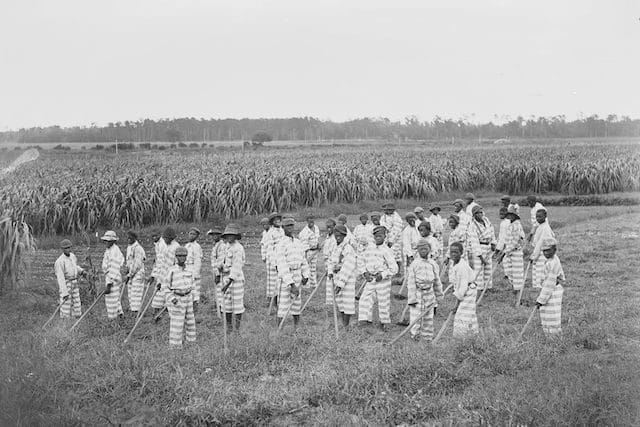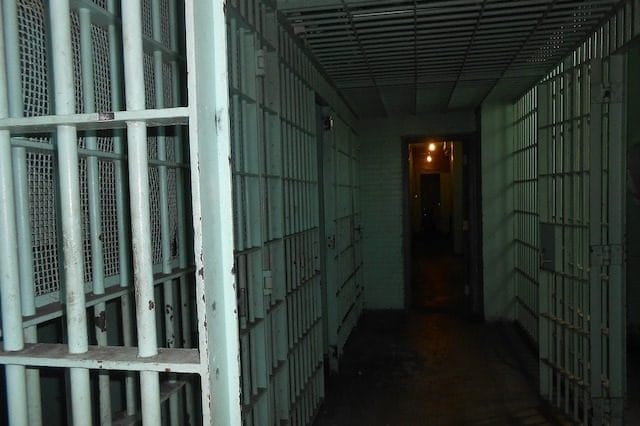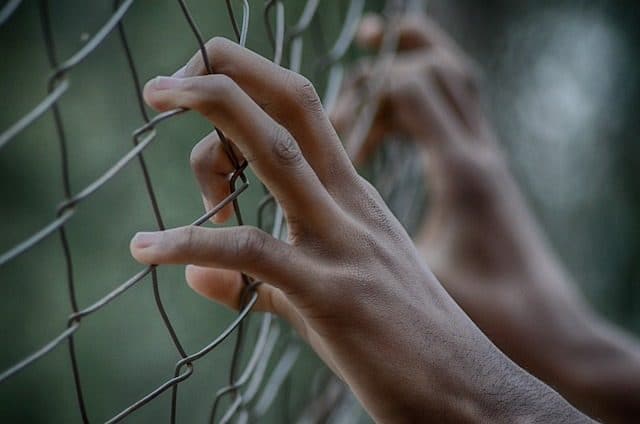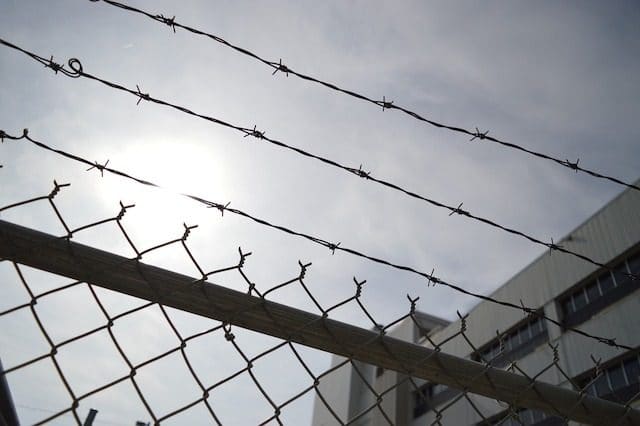There are many different estimates as to how many people are actually living in some type of slavery today — as it is often called by many different names — but most estimates put the number in the tens of millions. Regardless of the count, most people believe that if anything, any slaves within the United States are likely prostitutes or similar, and that hard labor slavery isn’t really a thing in the USA. However, it is not only quite a big thing, but it is a billion dollar industry that is legally sanctioned by the United States government — one of the only countries to legally allow slavery, though probably not quite in the form you’re thinking.
10. The Thirteenth Amendment Bans Slavery, But Has An Exception For Incarcerated Felons

Many people are confused about when slavery in the United States really ended, and for good reason. Some history books and teachers confuse children into thinking that the emancipation proclamation freed all of the slaves, but it actually only freed slaves that were within the states that were rebelling. So, not long after the United States passed the Thirteenth Amendment which officially outlawed slavery. However, the truth is that this amendment left a loophole a mile wide that was almost certainly meant to be — and was — exploited from the very start.
See, the amendment is quite clear that in most cases you cannot enslave someone and make them labor for free — except if the individual has been convicted and is serving time for a crime. In other words, slavery was illegal, except for incarcerated prisoners. Considering that the in the old South, free black men were often tried and convicted — or even lynched — for “crimes” like whistling at a white woman, it was very easy to quickly throw a lot of the recently freed black men back into legal slavery and force them once again to work for nothing, and be abused with no legal recourse. To this day, no real efforts have been made to change this amendment, and the powerful forces of the for profit prison industries would certainly put up great resistance if anyone were to try.
9. Prison Fill Quotas Incentivize States To Put People In Jail

If you ask many people, they will tell you that jails are supposed to help rehabilitate people in order to eventually make their way properly in civilian life. However, it is probably also clear to most people that the current system isn’t working, because our prison recidivism rate is horrific. More than 75% of people who go to jail in the United States end up returning to prison within five years, and the statistics really only get worse after that for people who end up in the clink twice. The problem is that while the public prison systems — that don’t really exist for profit — actually do want prisoners to rehabilitate, they often use the same general systems as the private, for profit prisons. And, as you might imagine, the for profit prisons like the high recidivism rate exactly where it is.
In fact, the for profit private prison complex in the United States is a multi-billion dollar industry that makes insane margins on the nearly free labor that the prisons they own and run provide them. Some of them, in their greed, have worked with state legislatures to pass laws that work to turn the United States into a true dystopia. They have had laws passed that make the state keep the prisons occupied up to a certain percentage, such as 75% or 90%. These “fill quotas” are enforced by financial penalties if the contract isn’t met, and it encourages the state to encourage local government to make their police and judges be as heavy on arrests and convictions as possible. Instead of spending time and money on better rehabilitation and making the community a better place, they have to spend all their time and money on cracking down on every lawbreaker for the slightest thing, or face worse yet financial penalties. The entire system is completely inane.
8. Some Private Prisons Pay Their Slaves A Pittance, Some Pay Them Nothing At All
If you are in a for profit private prison, then they can and will make you work, and you really have no choice in the matter — despite it being the year 2018, you are a slave and your labor does not belong to you. Now, some people may think that they can and will resist, but it is a foolish notion. If you refuse to work, you could find yourself put in isolation, which most people find to be its own torture very quickly, or you can have months or even years added to your time, or worse.
Some slavers are nicer than others, but it is a grim life in any case. In some situations the prison will offer the slaves a small pittance for their work — usually pennies on the dollar — and they can either save it or use it in the commissary. However, there are plenty of prisons that don’t pay the prisoners even a single penny for their work at all, give them only the food and other basic needs that they dole out to everyone, and they don’t really care if you don’t like it. These prisons are trying to maximize their profit, not be your friend, and in the end it really doesn’t matter what you like. Slavery for prisoners is perfectly allowed in the United States of America in the new millenium, and prisoners are probably the group whose social plight is cared about the least in the mind of the common populace.
7. Prison Slave Labor Produces Some Of Your Favorite Brands

Prison slave labor producing a staggering amount of American goods is one of the best kept secrets and something people tend to think about very little, but it truly supplies way more brands than most people would think. Inmates have been known to sew products for brands like Victoria’s Secret, JCPenney, Macy’s and others, as well as do basic grunt assembly for tech giants like Microsoft or Motorola. Prisoners have been made to produce everything from glasses, to road signs, body armor and mattresses. If you need cheap labor to assemble or sew things, prison labor costs next to nothing at all and the employees cannot quit or say no.
Many people were aware that prisoners made things like license plates, but the sheer scope of what they make is breathtaking. In many ways, their cheap labor helps keep America running as comfortably as it does. With corporations able to call on cheap and legal slave labor in their own country, they can keep costs down for the end consumer. Now this doesn’t mean there is no benefit at all, as the prisoners often still get paid a little something, but sometimes the skills they learn are dubious at best in terms of helping them on the outside, and the recidivism rates mean they are likely to end up returning anyway.
6. There Is No Motivation To Significantly Decrease Prison Recidivism Rates

One of the biggest issues in criminal justice in the United States is prison recidivism. For those of you not familiar with the term, this is a measure of likelihood of the return to prison of an individual who recently left, and the rates in the United States are shockingly high. The last formal review of prison statistics followed the release of over 400,000 prisoners released in 2005, and the rates it found were horrific. Within three years of release 67.8% of prisoners were back in the system, and within five years, it was up to 76.6%; even worse, more than half of these people were actually back in jail within the very first year.
Now, there are are some people out there trying to find a way to fix this, but there is little real motivation to do so. Many of the prisons in the United States are run for profit by private companies as we have mentioned, and they have no interest in spending money on making prisoners less likely to come right back into their arms. Quite the opposite, actually. Public prisons have more reason to actually fix the problem, but since they aren’t for profit, they don’t have the kind of lobbying power that the for private prison industry can bring to bear. With this cozy system in place, the private prison industry can relax knowing most people who enter their employ will belong to them for life.
5. Some Juvenile Prisoners Also Perform Labor For Free In The United States Of America
One of the dirtiest secrets of the United States is that they have so many juveniles locked up in jail — close to 50,000 back when data was compiled in 2015. Of these juveniles, about 1,000 of them are locked up at any given time in adult jails, with full on adult prisoners. However, to make matters worse, the rules of slavery in the 13th amendment don’t make any special exceptions for children, so many children locked up in jail are forced to work for nothing or next to nothing against their will. One particular facility called Walnut Grove suffered from so many abuses that it was closed back in 2016, although the gears of justice can grind slowly, as the reports of abuse started to come to light five years prior to that.
This particular jail was basically run by a bunch of various gangs in collusion with the guards, and was a very rare jail in that it housed juvenile and adult offenders together. The operators of the prison were so concerned with simply getting as much profit as possible out of the free labor locked up under their control, that they let the actions of the guards and the gangs get entirely out of hand in pursuit of money. At one point, they were getting in so many new prisoners that they decided to do a 500 bed expansion and increased their revenue by $3.4 million per year — they could have used some of these funds to reform the prison, but they just didn’t bother. While this particular prison may be an egregious example of abuse, there are tens of thousands more juvenile prisoners in the United States. Almost 75% of them are locked up for non-violent crimes, and many have to work against their will for almost nothing.
4. It’s Not Uncommon To Increase Your Sentence In Prison By “Doing Someone Else’s Time”

Another way that many prisoners increase their time enslaved to the big prison corporations happens while they are at prison, and keeps some from ever getting a chance to leave and play the recidivism game in the first place. This is called “doing someone else’s time” and it often happens when young and vulnerable prisoners get caught up with gangs. This can especially be tricky for those who did come in with non-violent offenses, because they are less likely to know how to avoid being exploited or bullied by those who did end up in prison for more intimidating reasons. The prisoners will join the gangs for protection both from other gangs and from the gang they are joining, and try to play the game in order to avoid any serious trouble while locked up. However, while it can be hard to avoid joining a gang, it can also be incredibly hazardous to your future freedom if you do.
Gangs will often force members to do things for them, sometimes as simple as carrying notes, but it can get increasingly illegal and likely to land you in hot water and increased jail time. As you do more tasks, you may be pressured into committing acts of violence for a more powerful gang member, forcing you to take the extra prison time and responsibility for his hit. This will increase your value to the gang and make them think you’re very loyal, but it will now be even harder to ever get out of the gang, and you may never find your way out of prison again.
3. Many Abuses Are Common, But People Simply Cannot Get That Worked Up About Prisoners
Prisons are full of abuses and the prisoners have little to no legal recourse. While the constitution does say no to cruel and unusual punishment, this is very much open to interpretation, and no one really expects prisoners to be comfortable or to be having a good time — they are there to be corrected after all, and in many people’s eyes there to be punished. This makes it difficult to make people care about the issues of prison slave labor, or any kind of bad things that happen to people while they are locked up. It is a common trope in every kind of popular media imaginable that you will potentially be raped in prison, forced to join a gang, or both, but the average person seems to care very little about doing anything about it.
Not long ago, it surfaced that women in Arizona state prison were finding it pretty much impossible to get enough tampons and pads. The amount they were rationed was simply not even close to enough for their periods, and with a starting base pay of about 15 cents an hour, buying more in the commissary was not really realistic either. Before long, a bill started to make its way through the house, to end the abuse and make sure that female prisoners had that one, simple, basic human dignity — until a male legislator killed the bill, and then everyone forgot about it. People also forget about the inmates left behind in New Orleans during Hurricane Katrina, and Sheriff Joe Arpaio made prisoners wear pink underwear — arguably cruel and unusual punishment — and kept them in a prison tent city in over 100 degree heat. Despite all of these abuses, and many others like them, the average person simply cannot get that upset about people locked up for committing crimes.
2. The Population Of For Profit Prison Slaves Is Mostly African-American And Hispanic
Many people hear about how there are an incredible amount of African-Americans in prison, and are shocked by the sheer numbers. However, some people try to downplay the numbers, suggesting that while there is a higher percentage of black people in prison, that there are still more white people overall. This, unfortunately, is actually not true at all. At last count, it was 33% African-American, 30% white, and 23% Hispanic. This means that there is not only a higher percentage of the black population in prison than any other race, there is also a higher raw number in prison as well.
To make matters worse, even if the number of African-American prisoners dropped a bit and they were no longer the highest sheer number of people in prison when it comes to race, they would still be disproportionately hit based on the percentage of the population that is African-American — about 12%. Considering that many poor communities in the nation are mostly black communities, and how hard it can be for a poor community to become anything more, this unfortunate problem is not likely to go away anytime soon. Like any issue, actively trying to deal with the root cause is the only way to truly bring about real change.
1. Above All, The Poor Are Affected More Than Any Others Across All Demographics
This may not be a huge surprise to most people, but above all else, poverty seems to be the biggest factor when it comes to ending up in prison and being trapped in the slave system for the rest of your life. Looking at the statistics, children born to the bottom 10% of earners are 20 times more likely to end up in prison than those born to the top 10%. In general, the poorer you are the more likely you are to end up in prison, with those who grow up in fairly isolated poorer communities being the most at risk — being minority makes your odds even worse, of course.
Now, there are multiple reasons for this, and all of them are basically economic. Richer people are less likely to commit crimes meant to sustain life like stealing food, or crimes of desperation meant to steal just enough to pawn to survive and pay your bills. On top of that, the more money you have, the better a lawyer you will be able to hire, and the better educated you will be. If you are better educated, you will have a better understanding of the legal system in general, and of course more money means more time to fight the charges on your own or deal with community service or other options. The rich simply have way more means to fight charges whereas the poor are more likely to take a fairly bad deal and end up being stuck with it. With very little education to begin with and no family with deep pockets, when they get out, they soon find themselves right back in and a slave to the system for life.
9 Comments
Hmm… guess they shouldn’t be committing crime, then, huh?
Treating people like criminals only reinforces their belief they are criminals. Treating people like humans reinforces their belief they are human.
So you’re saying that when criminals commit crimes, we shouldn’t treat them as if they were criminals who had committed crimes? Is that your serious solution: treat them all as if they’re what they aren’t?
Here’s a thought: criminals know that committing crimes is wrong and will result in them going to prison, and yet they do so anyway. Their behavior is a choice and no one’s fault but their own.
Thank you for proving the author’s point!
Exactly how did this happen?